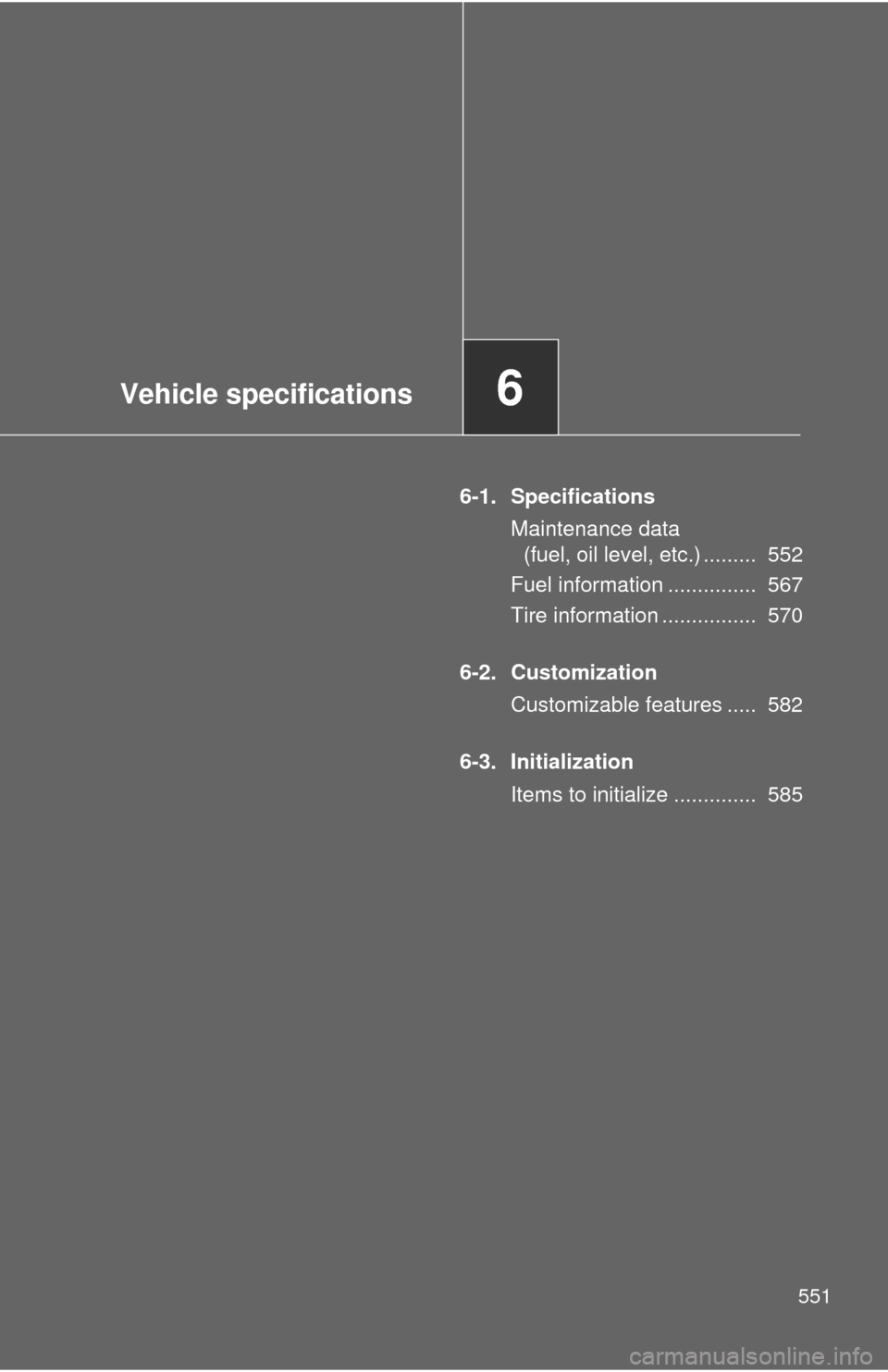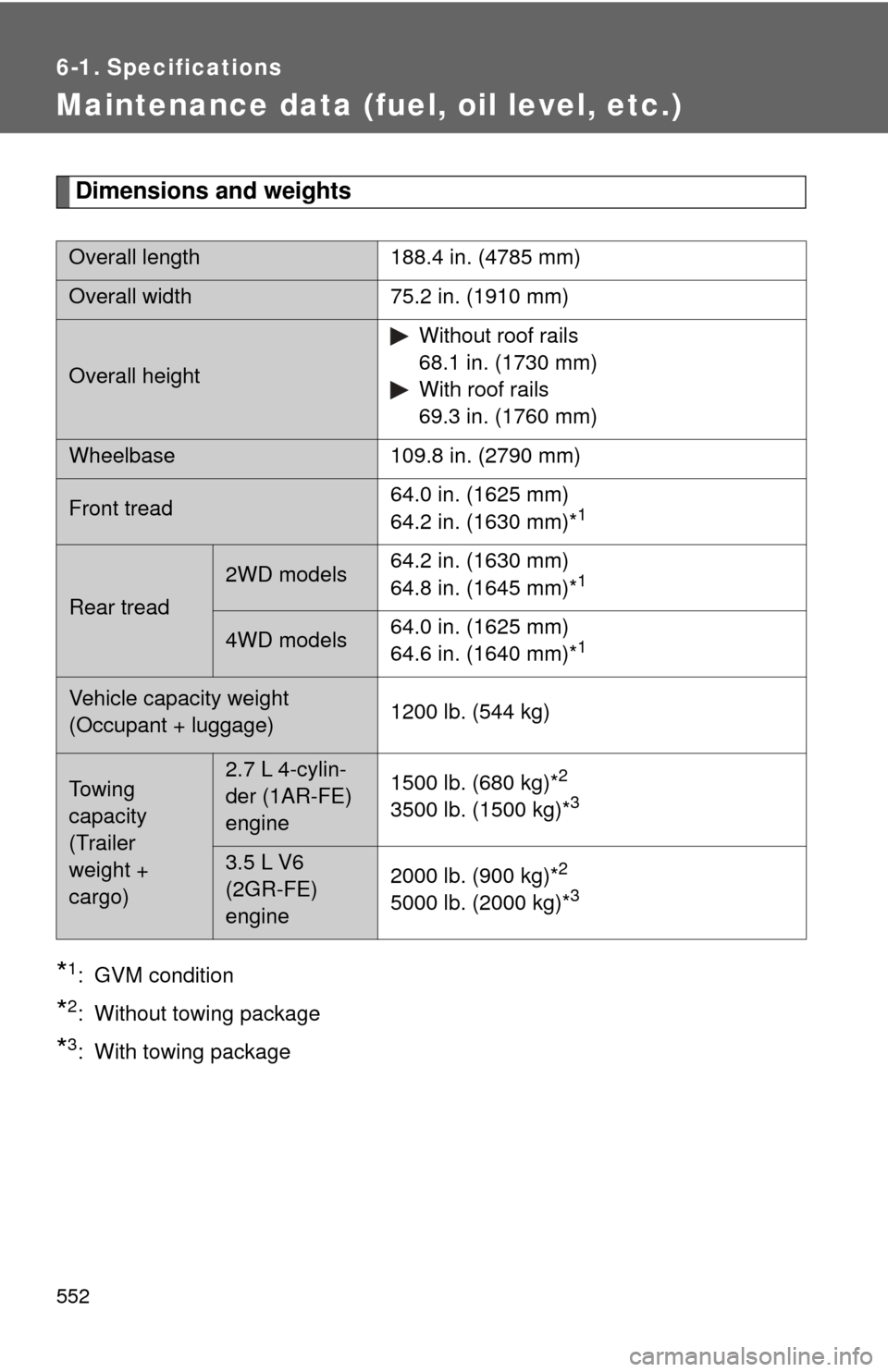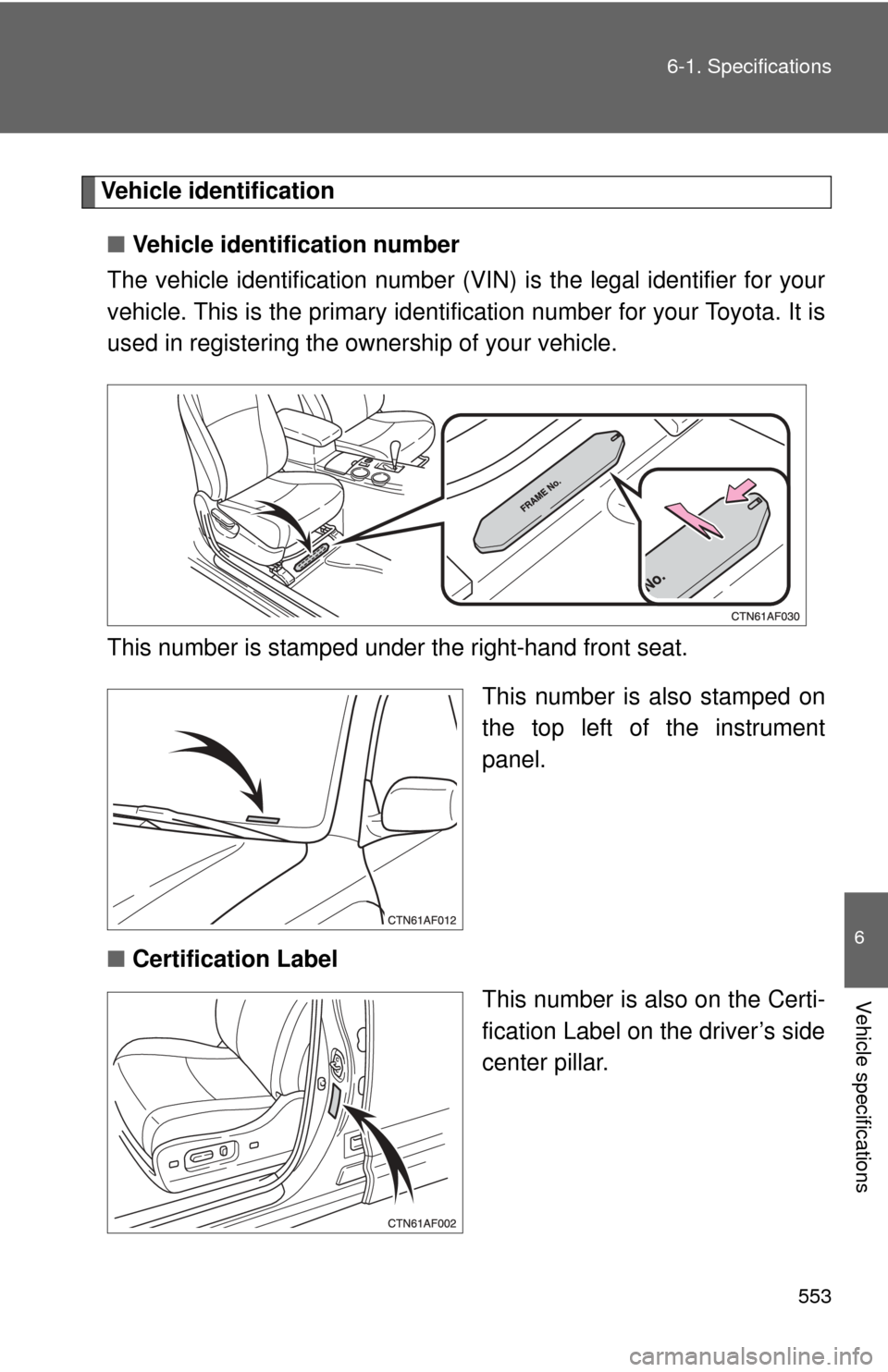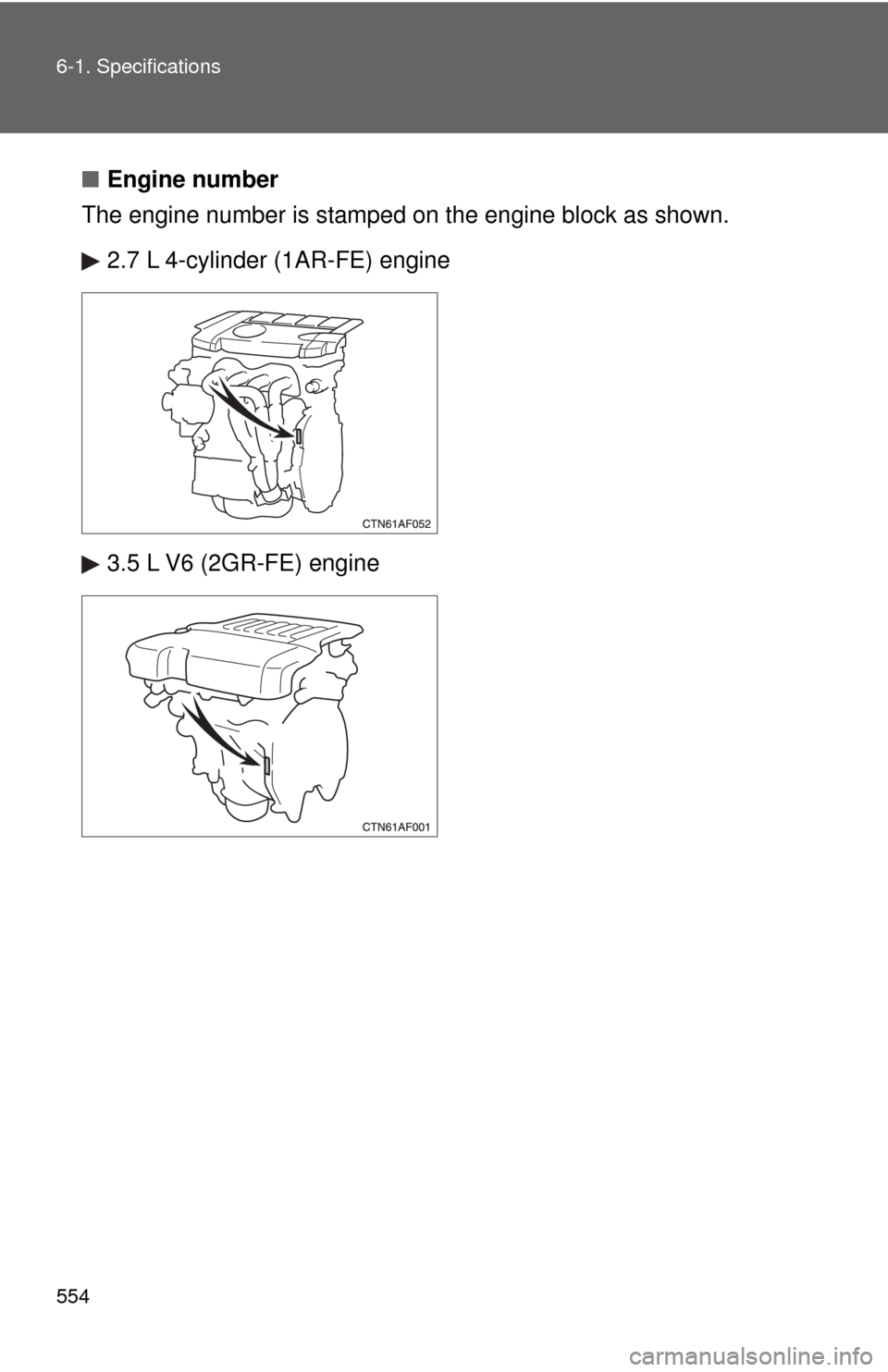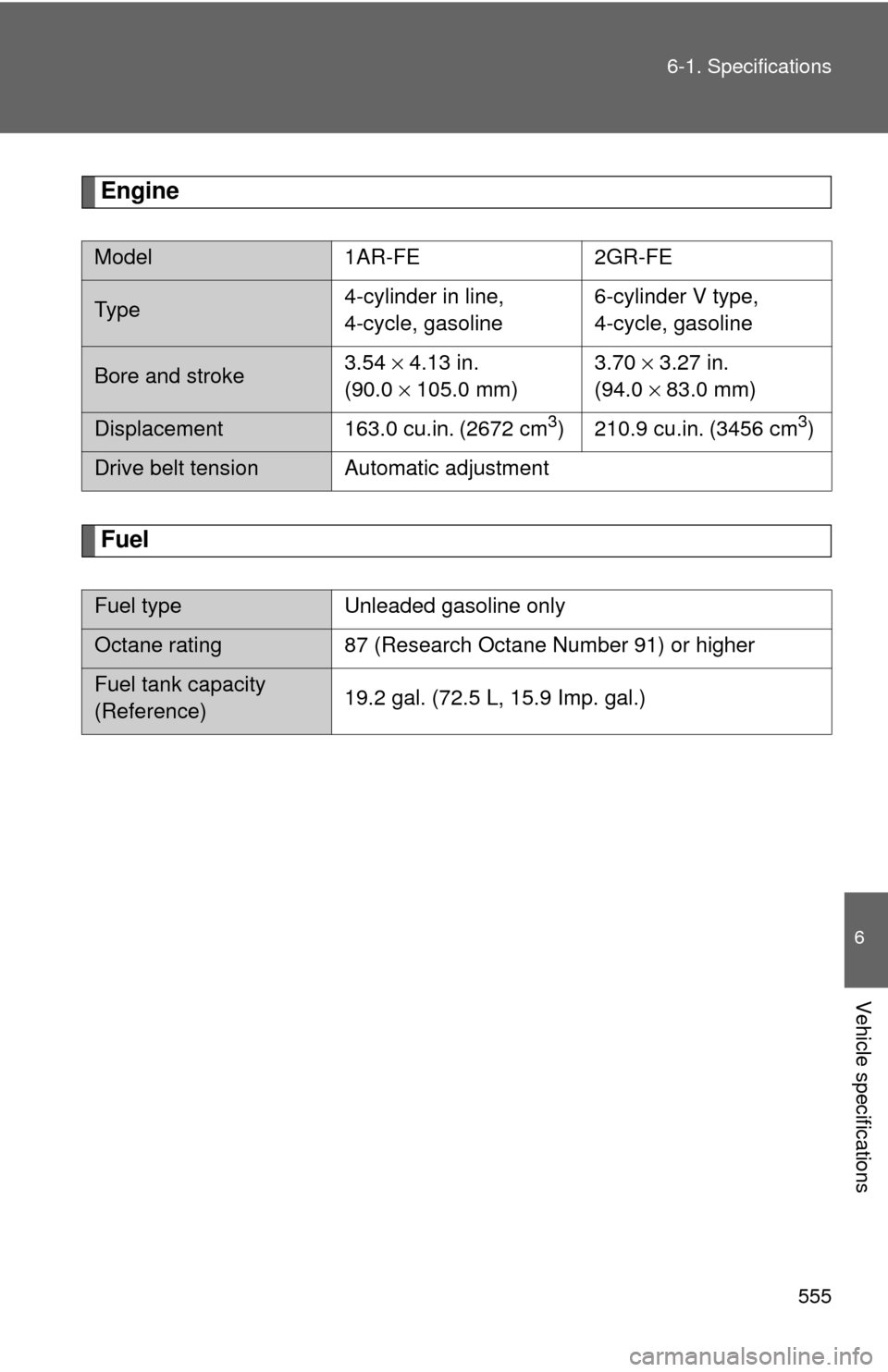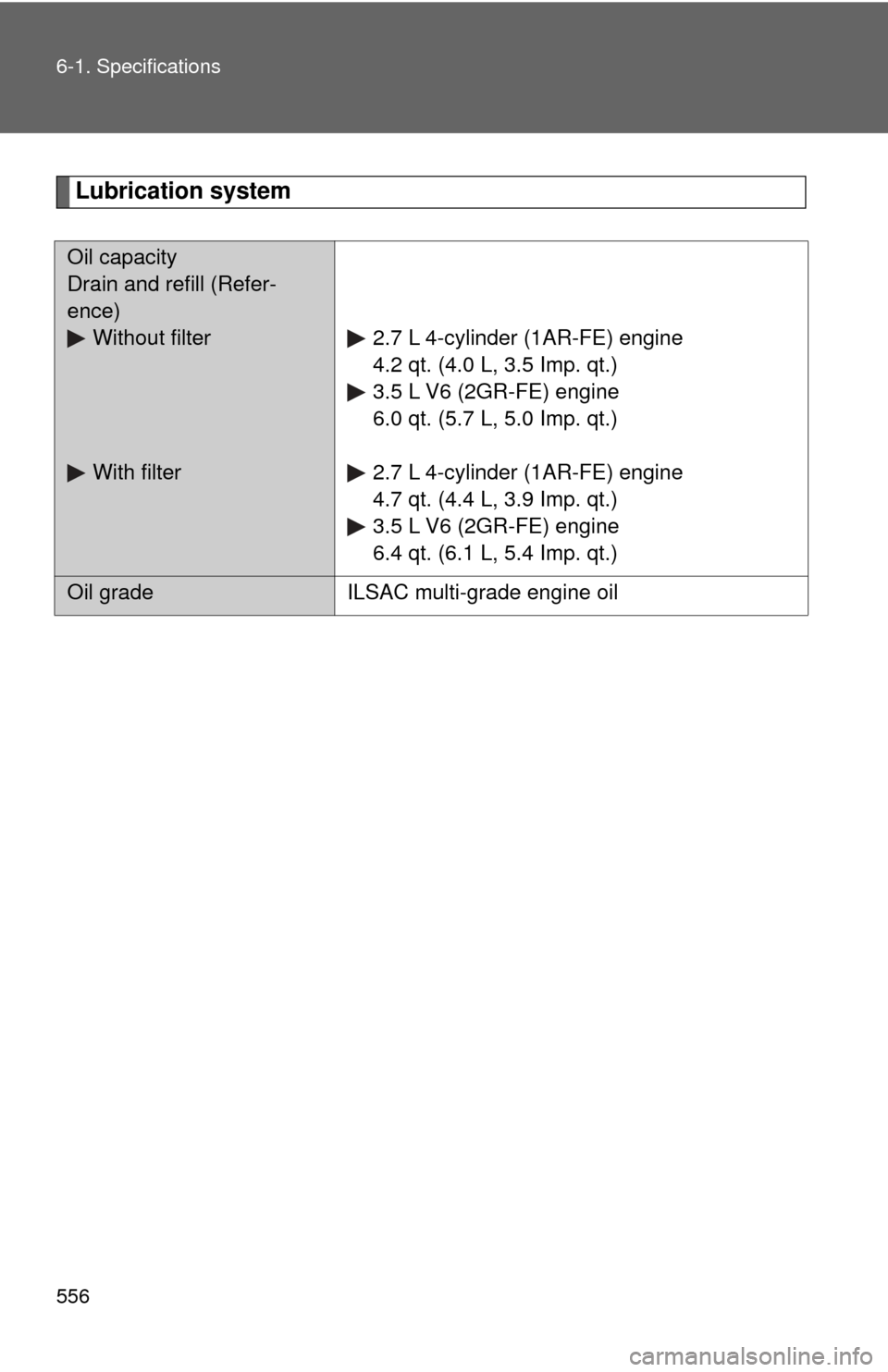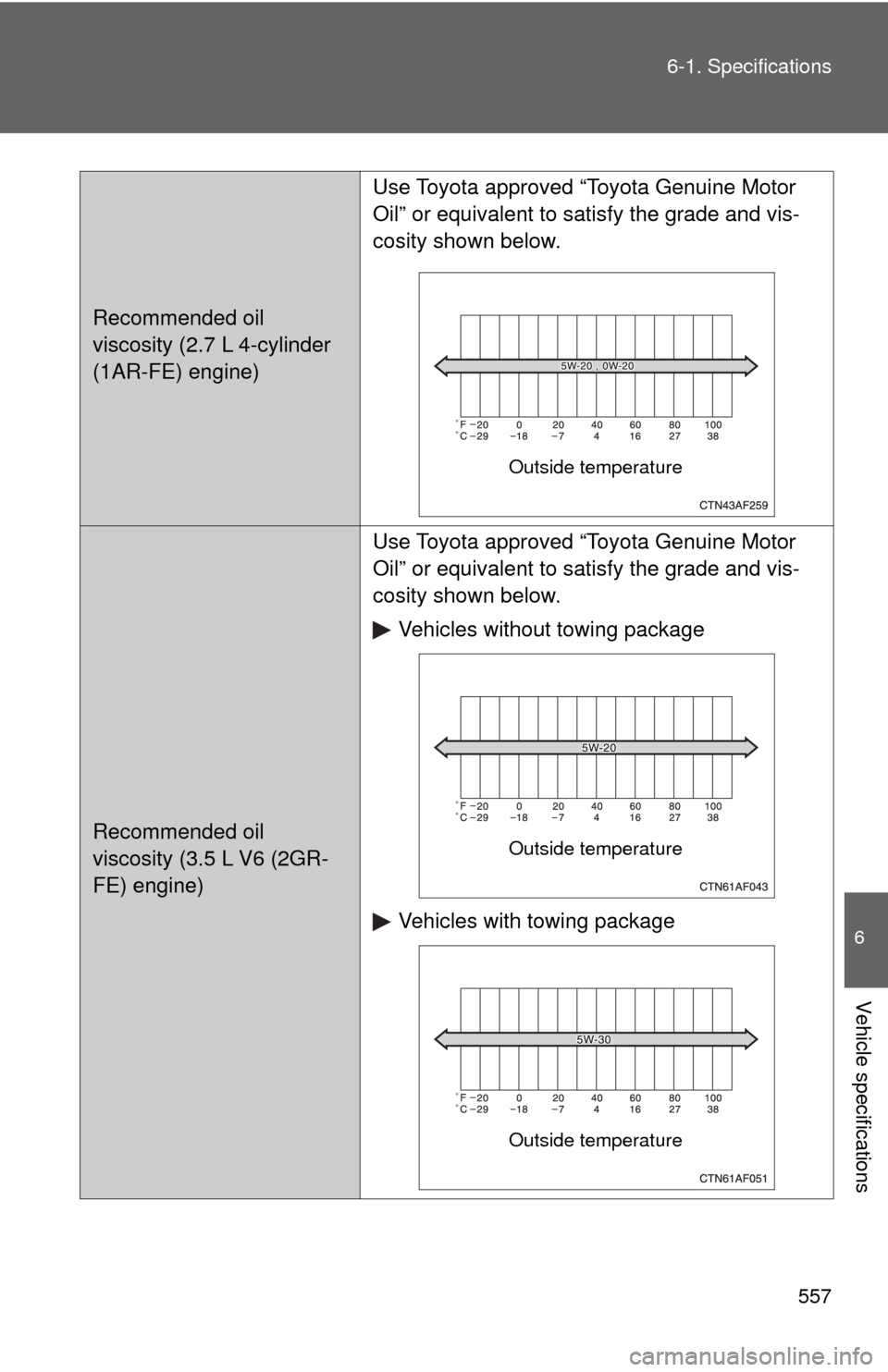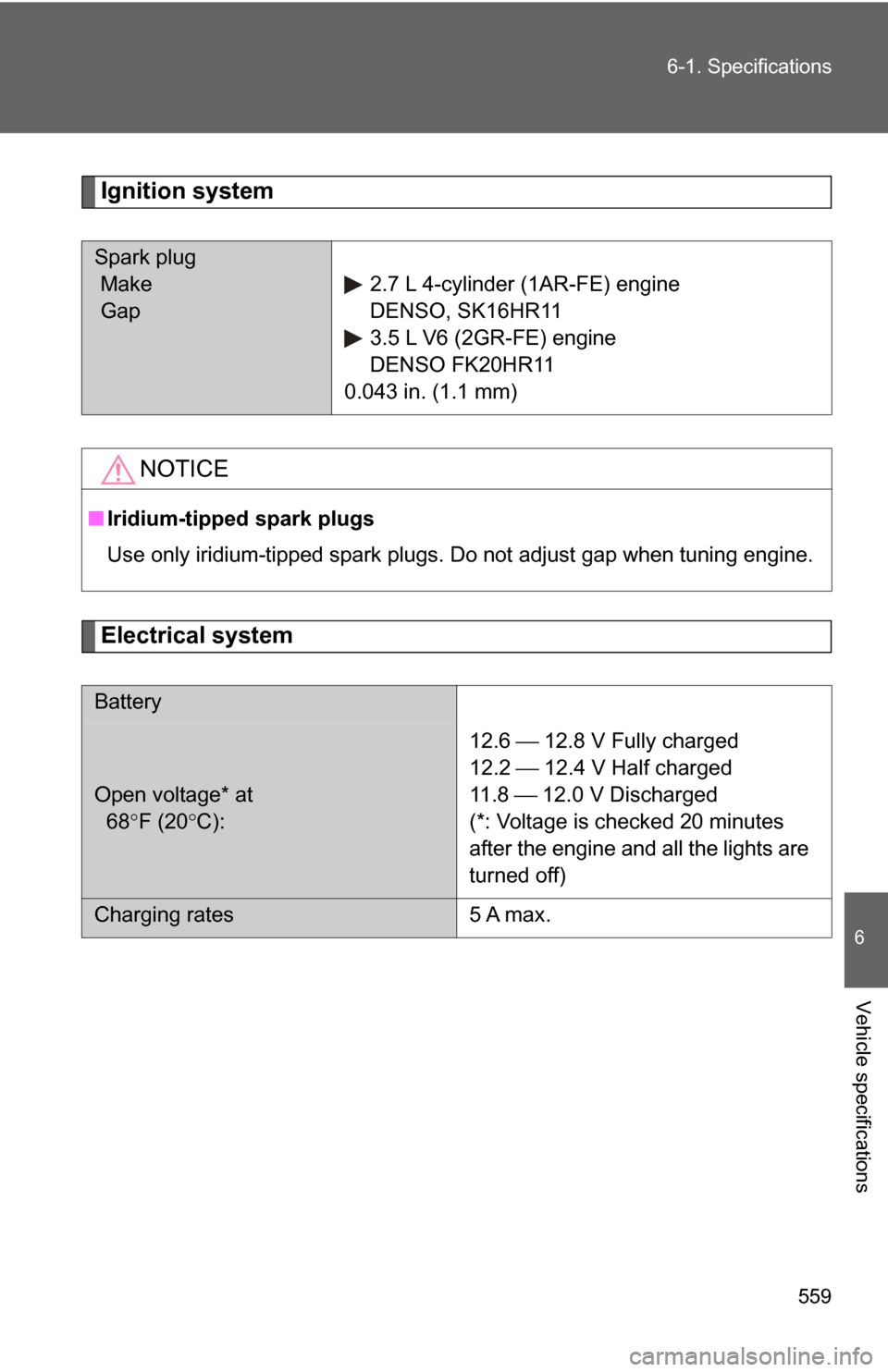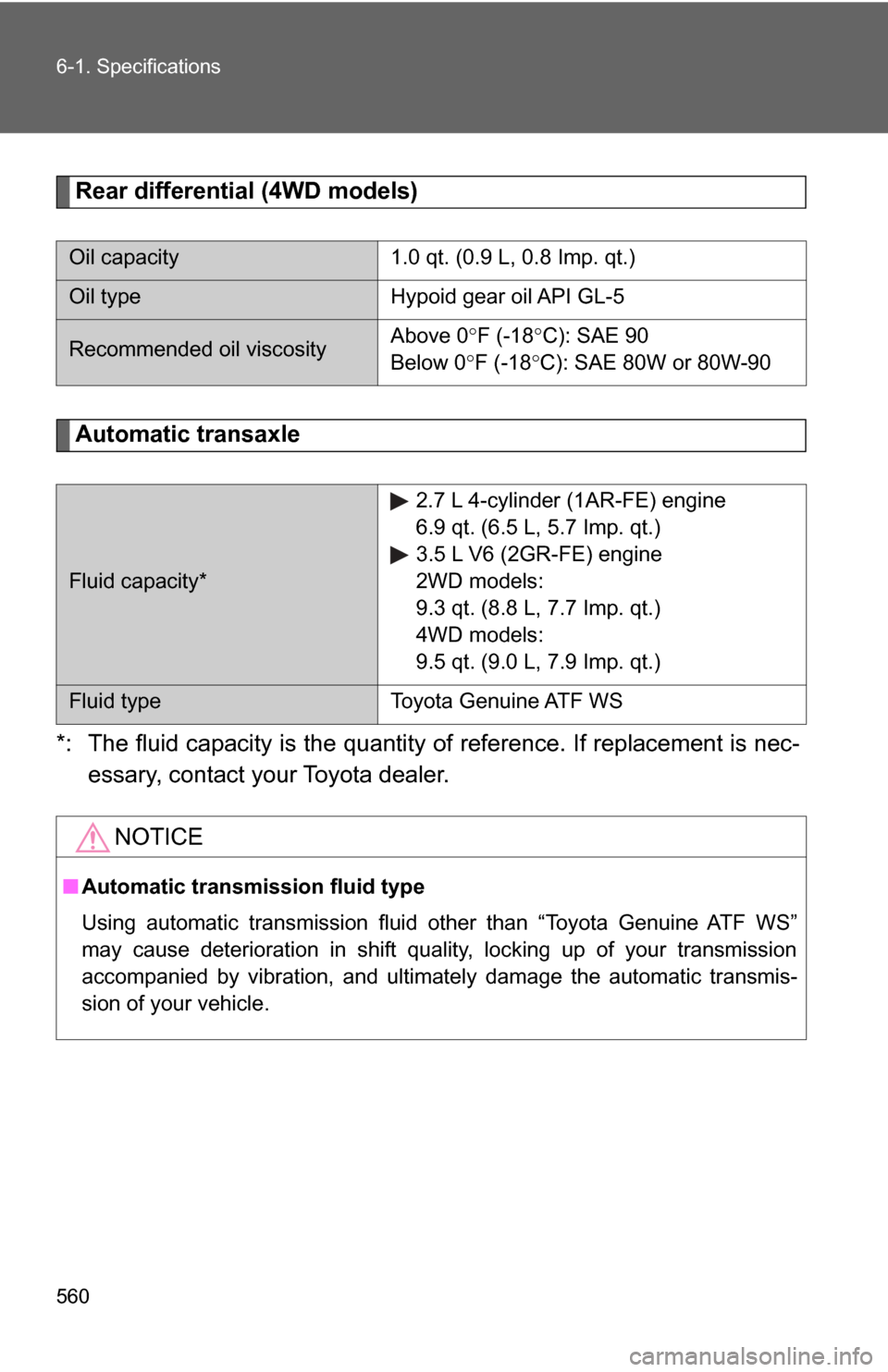TOYOTA HIGHLANDER 2009 XU40 / 2.G Owners Manual
HIGHLANDER 2009 XU40 / 2.G
TOYOTA
TOYOTA
https://www.carmanualsonline.info/img/14/6399/w960_6399-0.png
TOYOTA HIGHLANDER 2009 XU40 / 2.G Owners Manual
Trending: reset, fuel reserve, wipers, catalytic converter, wiper size, key battery, lights
Page 551 of 608
Vehicle specifications6
551
6-1. SpecificationsMaintenance data (fuel, oil level, etc.) ......... 552
Fuel information ............... 567
Tire information ................ 570
6-2. Customization Customizable features ..... 582
6-3. Initialization Items to initialize .............. 585
Page 552 of 608
552
6-1. Specifications
Maintenance data (fuel, oil level, etc.)
Dimensions and weights
*1: GVM condition
*2: Without towing package
*3: With towing package
Overall length188.4 in. (4785 mm)
Overall width75.2 in. (1910 mm)
Overall height Without roof rails
68.1 in. (1730 mm)
With roof rails
69.3 in. (1760 mm)
Wheelbase
109.8 in. (2790 mm)
Front tread 64.0 in. (1625 mm)
64.2 in. (1630 mm)*1
Rear tread
2WD models64.2 in. (1630 mm)
64.8 in. (1645 mm)*1
4WD models64.0 in. (1625 mm)
64.6 in. (1640 mm)*1
Vehicle capacity weight
(Occupant + luggage) 1200 lb. (544 kg)
Towing
capacity
(Trailer
weight +
cargo)2.7 L 4-cylin-
der (1AR-FE)
engine1500 lb. (680 kg)*2
3500 lb. (1500 kg)*3
3.5 L V6
(2GR-FE)
engine2000 lb. (900 kg)*2
5000 lb. (2000 kg)*3
Page 553 of 608
553
6-1. Specifications
6
Vehicle specifications
Vehicle identification
■ Vehicle identification number
The vehicle identificati on number (VIN) is the legal identifier for your
vehicle. This is the primary identific ation number for your Toyota. It is
used in registering the ownership of your vehicle.
This number is stamped under the right-hand front seat.
This number is also stamped on
the top left of the instrument
panel.
■ Certification Label
This number is also on the Certi-
fication Label on the driver’s side
center pillar.
Page 554 of 608
554 6-1. Specifications
■Engine number
The engine number is stamped on the engine block as shown.
2.7 L 4-cylinder (1AR-FE) engine
3.5 L V6 (2GR-FE) engine
Page 555 of 608
555
6-1. Specifications
6
Vehicle specifications
Engine
Fuel
Model
1AR-FE2GR-FE
Ty p e 4-cylinder in line,
4-cycle, gasoline6-cylinder V type,
4-cycle, gasoline
Bore and stroke
3.54 ×
4.13 in.
(90.0 × 105.0 mm) 3.70 ×
3.27 in.
(94.0 × 83.0 mm)
Displacement 163.0 cu.in. (2672 cm3) 210.9 cu.in. (3456 cm3)
Drive belt tension Automatic adjustment
Fuel type Unleaded gasoline only
Octane rating87 (Research Octane Number 91) or higher
Fuel tank capacity
(Reference) 19.2 gal. (72.5 L, 15.9 Imp. gal.)
Page 556 of 608
556 6-1. Specifications
Lubrication system
Oil capacity
Drain and refill (Refer-
ence)Without filter
With filter 2.7 L 4-cylinder (1AR-FE) engine
4.2 qt. (4.0 L, 3.5 Imp. qt.)
3.5 L V6 (2GR-FE) engine
6.0 qt. (5.7 L, 5.0 Imp. qt.)
2.7 L 4-cylinder (1AR-FE) engine
4.7 qt. (4.4 L, 3.9 Imp. qt.)
3.5 L V6 (2GR-FE) engine
6.4 qt. (6.1 L, 5.4 Imp. qt.)
Oil grade
ILSAC multi-grade engine oil
Page 557 of 608
557
6-1. Specifications
6
Vehicle specifications
Recommended oil
viscosity (2.7 L 4-cylinder
(1AR-FE) engine)
Use Toyota approved “Toyota Genuine Motor
Oil” or equivalent to satisfy the grade and vis-
cosity shown below.
Recommended oil
viscosity (3.5 L V6 (2GR-
FE) engine)Use Toyota approved “Toyota Genuine Motor
Oil” or equivalent to satisfy the grade and vis-
cosity shown below.
Vehicles without towing package
Vehicles with towing package
Outside temperature
Outside temperature
Outside temperature
Page 558 of 608
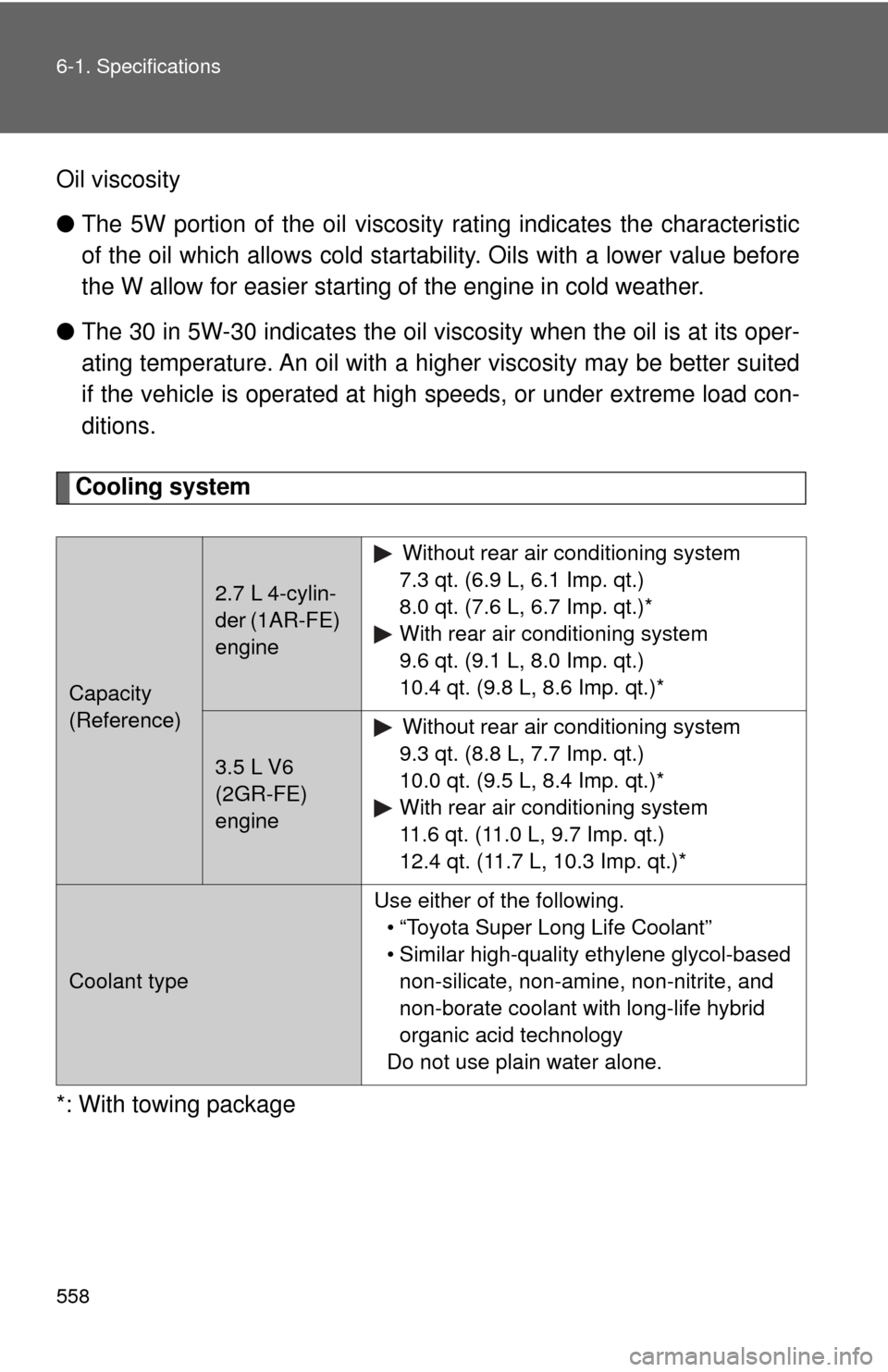
558 6-1. Specifications
Oil viscosity
●The 5W portion of the oil viscosity rating indicates the characteristic
of the oil which allows cold startabi lity. Oils with a lower value before
the W allow for easier starting of the engine in cold weather.
● The 30 in 5W-30 indicates the oil visc osity when the oil is at its oper-
ating temperature. An oil with a hi gher viscosity may be better suited
if the vehicle is operated at high speeds, or under extreme load con-
ditions.
Cooling system
*: With towing package
Capacity
(Reference)
2.7 L 4-cylin-
der (1AR-FE)
engine Without rear air conditioning system
7.3 qt. (6.9 L, 6.1 Imp. qt.)
8.0 qt. (7.6 L, 6.7 Imp. qt.)*
With rear air conditioning system
9.6 qt. (9.1 L, 8.0 Imp. qt.)
10.4 qt. (9.8 L, 8.6 Imp. qt.)*
3.5 L V6
(2GR-FE)
engine Without rear air conditioning system
9.3 qt. (8.8 L, 7.7 Imp. qt.)
10.0 qt. (9.5 L, 8.4 Imp. qt.)*
With rear air conditioning system
11.6 qt. (11.0 L, 9.7 Imp. qt.)
12.4 qt. (11.7 L, 10.3 Imp. qt.)*
Coolant type Use either of the following.
• “Toyota Super Long Life Coolant”
• Similar high-quality ethylene glycol-based non-silicate, non-amine, non-nitrite, and
non-borate coolant with long-life hybrid
organic acid technology
Do not use plain water alone.
Page 559 of 608
559
6-1. Specifications
6
Vehicle specifications
Ignition system
Electrical system
Spark plug
Make
Gap
2.7 L 4-cylinder (1AR-FE) engine
DENSO, SK16HR11
3.5 L V6 (2GR-FE) engine
DENSO FK20HR11
0.043 in. (1.1 mm)
NOTICE
■ Iridium-tipped spark plugs
Use only iridium-tipped spark plugs. Do not adjust gap when tuning engine.
Battery
Open voltage* at
68° F (20 °C): 12.6
⎯ 12.8 V Fully charged
12.2 ⎯ 12.4 V Half charged
11.8 ⎯ 12.0 V Discharged
(*: Voltage is checked 20 minutes
after the engine and all the lights are
turned off)
Charging rates 5 A max.
Page 560 of 608
560 6-1. Specifications
Rear differential (4WD models)
Automatic transaxle
*: The fluid capacity is the quantity of reference. If replacement is nec- essary, contact your Toyota dealer.
Oil capacity 1.0 qt. (0.9 L, 0.8 Imp. qt.)
Oil typeHypoid gear oil API GL-5
Recommended oil viscosityAbove 0
°F (-18 °C): SAE 90
Below 0 °F (-18 °C): SAE 80W or 80W-90
Fluid capacity* 2.7 L 4-cylinder (1AR-FE) engine
6.9 qt. (6.5 L, 5.7 Imp. qt.)
3.5 L V6 (2GR-FE) engine
2WD models:
9.3 qt. (8.8 L, 7.7 Imp. qt.)
4WD models:
9.5 qt. (9.0 L, 7.9 Imp. qt.)
Fluid type
Toyota Genuine ATF WS
NOTICE
■Automatic transmission fluid type
Using automatic transmission fluid other than “Toyota Genuine ATF WS”
may cause deterioration in shift quality, locking up of your transmission
accompanied by vibration, and ultimately damage the automatic transmis-
sion of your vehicle.
Trending: CD changer, change time, winter tires, octane, snow chains, ignition, tow
